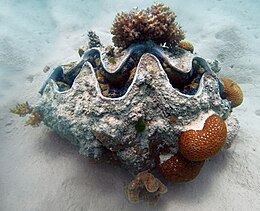| Tridacna | |
|---|---|

| |
| Giant clam (T. gigas), Michaelmas Cay, QVD | |
| Scientific classification | |
| Domain: | Eukaryota |
| Kingdom: | Animalia |
| Phylum: | Mollusca |
| Class: | Bivalvia |
| Order: | Cardiida |
| Superfamily: | Cardioidea |
| Family: | Cardiidae |
| Subfamily: | Tridacninae |
| Genus: | Tridacna Bruguière, 1797 |
| Synonyms | |
| |

Drawing of a Tridacna spp. (NOAA)
Tridacna is a genus of large saltwater clams, marine bivalve molluscs in the subfamily Tridacninae, the giant clams. Many Tridacna species are threatened. They have heavy shells, fluted with 4 to 6 folds. The mantle is often brightly coloured. They inhabit shallow waters of coral reefs in warm seas of the Indo-Pacific region.[2] These clams are popular in marine aquaria, and in some areas, such as the Philippines, members of the genus are farmed for the marine aquarium trade. They live in symbiosis with photosynthetic algae (zooxanthellae). Some species are eaten by humans.
All species in the genus Tridacna are protected under CITES Appendix II.[3]
- ^ "The Paleobiology Database". Paleodb.org. Retrieved 2012-05-20.
- ^ Huelsken, T., Keyse, J., Liggins, L., Penny, S., Treml, E.A., Riginos, C. (2013) A Novel Widespread Cryptic Species and Phylogeographic Patterns within Several Giant Clam Species (Cardiidae: Tridacna) from the Indo-Pacific Ocean. PLoS ONE, DOI: 10.1371/journal.pone.0080858.
- ^ "Checklist of CITES species".